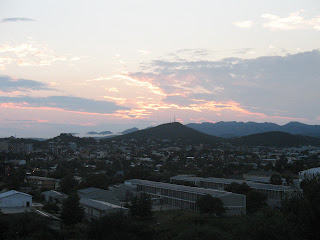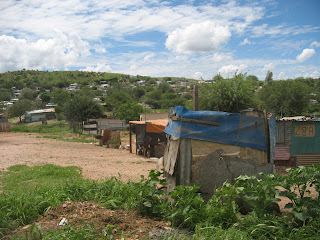In regards to wealth disparity, South Africa is claimed to be one of the most unequal societies in the world. My South African experience has been defined by contrasts. I have seen it in the extreme discrepancies in housing, sanitation and education. I have also seen it in more subtle forms that intricately affect daily life. I will provide a brief description of the system which has helped create and maintain these contrasts, before talking about my specific experiences.
Apartheid is an Afrikaners word that means “separateness” and was implemented in South Africa from 1948-1994. The ugly cousin of segregation, apartheid intended to keep both black, colored and white separate from each other. It ended up taking away many freedoms from blacks through inhumane laws, conditions and an institutional system of white privilege (further info: http://www.africanaencyclopedia. com/apartheid/ apartheid.html). While apartheid is no longer in existence its legacy remains very much engrained in South African society. The deep wounds inflicted during this part of history will take years of mending and reconciliation.
During my time in the Jo-burg region I was fortunate enough to visit Soweto (SOuth WEstern TOwnships), the most important area in the liberation struggle in South Africa. Soweto was originally created in 1904 and is the largest metropolitan area in the country (further info: http://www.joburg. org.za/soweto). I will talk briefly about some of the different sites we have visited during our time in Soweto that are specifically connected to the liberation struggle:
Regina Mundi Church- A catholic church located in the center of Soweto and at the heart of the liberation struggle. A place of refuge for the oppressed, although it contains several bullet holes around the alter from police during the 1976 uprisings (further info: http://www.soweto.co.za/html/ ven_regina_mundi.htm)
Morris Isaacson School- Start of the 1976 student march against education taught in Afrikaans. We drove along the route that the students took.
Hector Pieterson Museum- We heard the inspiring story behind the iconic photograph of Hector Pieterson told by his sister, Antoinette Sithole. Hector was killed during the uprisings. The museum illustrated the history of the 1976 student uprisings and its ramifications (further info: http://www. southafrica.info/about/history/ hector-pieterson.htm).
Apartheid Museum- Covers the racial history of South Africa with a particular focus on the liberation struggle and life under the apartheid system. Before entering, the ticket you receive determines the race that you will be for a short portion of the journey (this is fitting as people don’t choose the color of their skin- it is given to them). One door is for blacks and the other whites illustrating the type of signs and profiles that people of a particular race would be accustomed to seeing during the apartheid era (further info: http://www. apartheidmuseum.org).
Nelson Mandela’s house- Contained a lot of history of the Mandela family. Each member of the family has had their umbilical cords buried under a tree which is symbolic of humanity coming from and making up the earth. The house was an important meeting place during the liberation struggle. Mandela visited it soon after he was released from jail in 1990 (further info: http://www.mandelahouse.com/ history.asp).
Freedom Charter- Ten idealistic rights set about by the South African Congress Alliance in 1955. The main purpose was to give freedom to the people and rights included “The people should govern” and “All shall be equal before the law.” A large round table stated each of the ten rights with a further explanation (further info: http://www.anc.org.za/show.php?include=docs/misc/1955/charter.html).
One of the most defining elements of our time in Jo-burg has been listening to a variety of perspectives provided from a range of speakers:
Anti-privatization Forum Activists- A group trying to push for more governmental housing, so that better housing standards are established in South Africa (particularly in Soweto).
Mr. Mataboge (Liberation Struggle in South Africa)- Provided an historical framework for the liberation movement and what it means to South Africans today.
Dale McKinley (South Africa’s Political Economy)- An informative journey into the political and economic struggles that are currently facing South Africa.
Dr David Fig (Nuclear Energy and Environment in South Africa)- An attack against nuclear energy for being bad on the environment and not economically viable. An assessment of various sustainable energy options was provided.
Nokhwezi Hoboyi (Treatment Action Campaign)- Provided insight into the difficulties of HIV/AIDS, with a focus on stigmatization and prevention (further info: http://www.tac.org.za/community/about).
South African Council of Churches (SACC)- A religious understanding of South Africa, the issues that face the church today and an assessment of various ecological problems needing a fix (further info: http://www. sacc.org.za/about.html).
Khulumani Support Group- A discussion of truth, memory and storytelling as part of reconciliation efforts in South Africa. Highlighted current environmental problems almost unknown to the western world (further info: http://www.khulumani.net/).
ANC representative- Provided some insight into South African politics, but lacked substance or direction (further info: http://www.anc.org.za/).
Democratic Alliance (DA)- A comprehensive analysis of political history and culture in South Africa with an emphasis on the work of the DA (further info: http://www.da.org.za/).
Other valuable experiences from the Jo-burg area include:
Semi-Private School in Soweto- We were taken around an entirely black school by groups of students into various classrooms from 8-12th grade. We stood in front of classes making introductions and in smaller groups answering student questions. Students were insightful, inquisitive and had an incredible passion for learning and life. I got to see a geography class and learnt about weather differences between different latitudes.
Kliptown (township of Soweto)- The poorest of poor live here in shantytown style housing. Often corrugated tin roofing and a “shit in a bucket” system in which the bucket is taken to be cleaned after each week (further info: http://www.southafrica.info/about/history/kliptown-220605.htm).
Songs of Migration at Market Theatre- Over 40 different songs conveyed through a variety of different languages and musical styles. A theatrical performance detailing the migration of blacks to areas of mining in the Jo-burg region. Extremely powerful with a band of two guitarists, pianist, singer, drummer and trumpeter taking center stage (further info: http://markettheatre.co.za/shows/ watch/songs-of-migration).
Mall shopping (Maponya, Southgate, Bruma & Sandton)- We managed to see a variety of malls during our time in the Jo-burg area. It highlighted the injustice between predominantly white and black areas and the wealth of the new black middle class. For example, Maponya mall in Soweto is marketed towards Sowetans (but only around 10% of the population can afford to shop here). Sandton (a predominately white area) mall is claimed as the richest mall in all of Africa and sometimes in all of the Southern Hemisphere.
Constitution Hill- Commemorated South Africa’s constitution (claimed as one of the most liberal constitutions in the world and includes rights for homosexual people), a fort that housed prisoners during the apartheid era up to 1983 (including Nelson Mandela for a short time) and the more recently established constitutional court. The theme of the court is “justice under a tree” as this was historically how justice was done in the African tradition (further info: http://www.constitutionhill.org.za/).
Just a few highlights from my journey in the Jo-burg area!


















